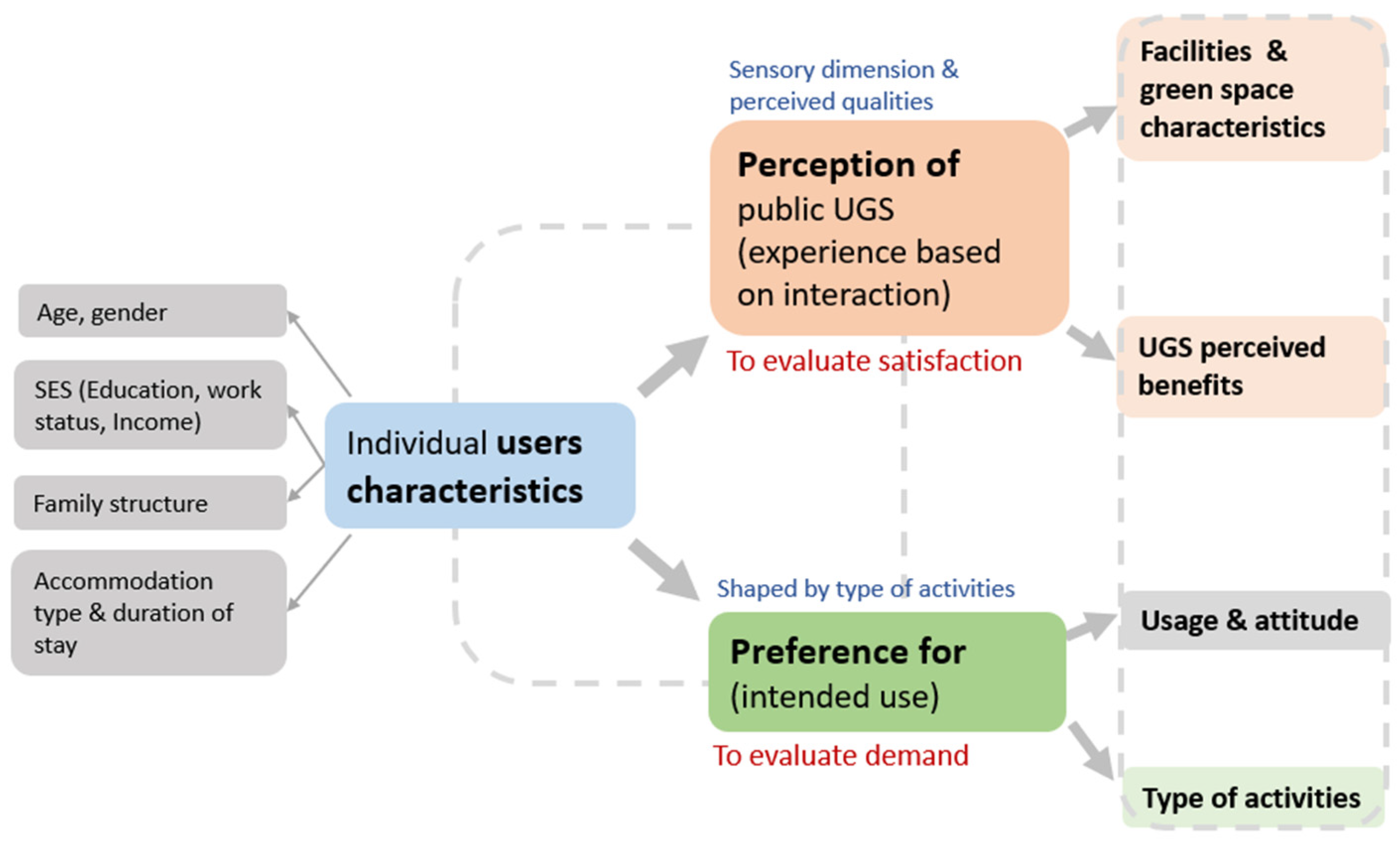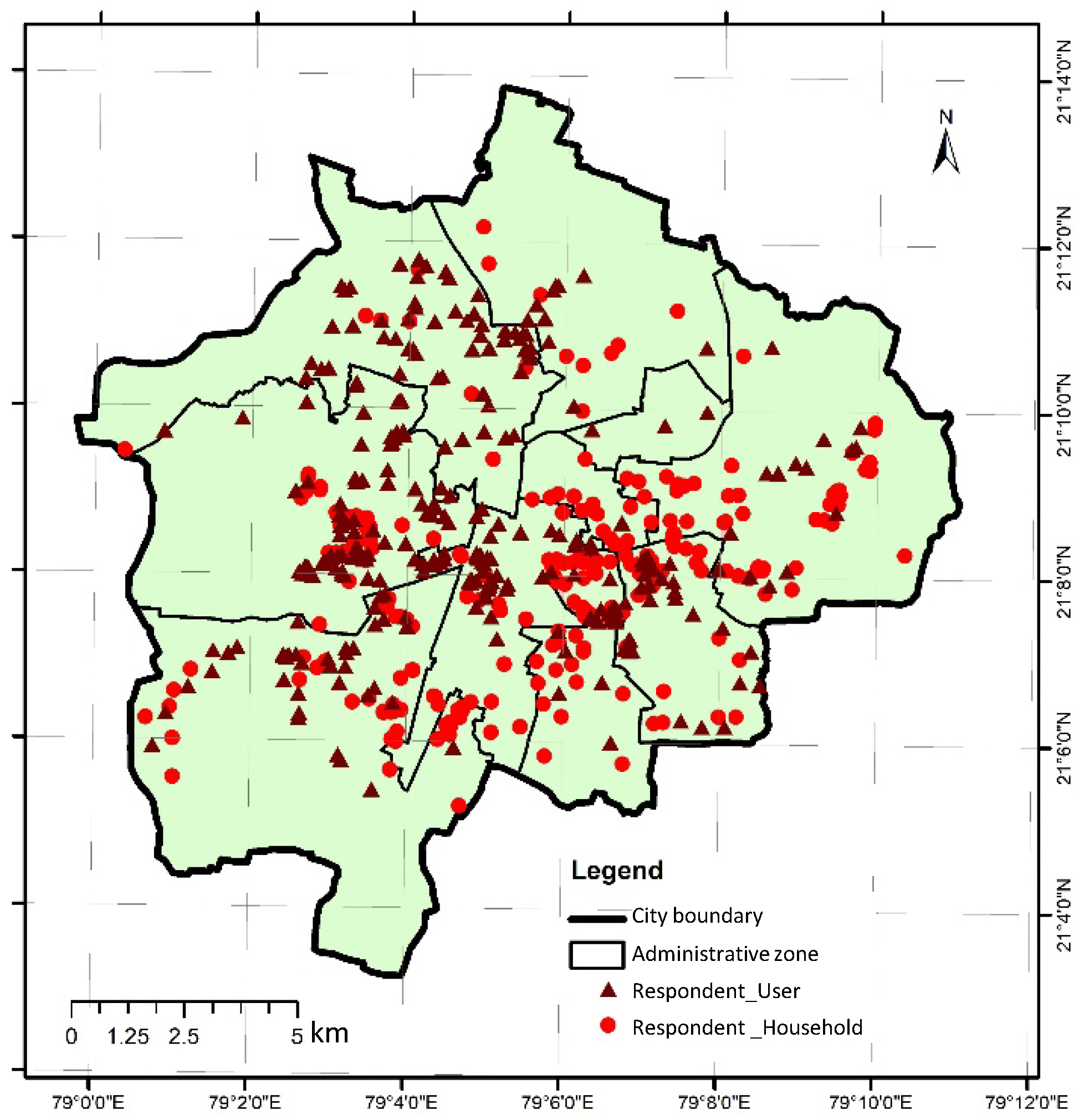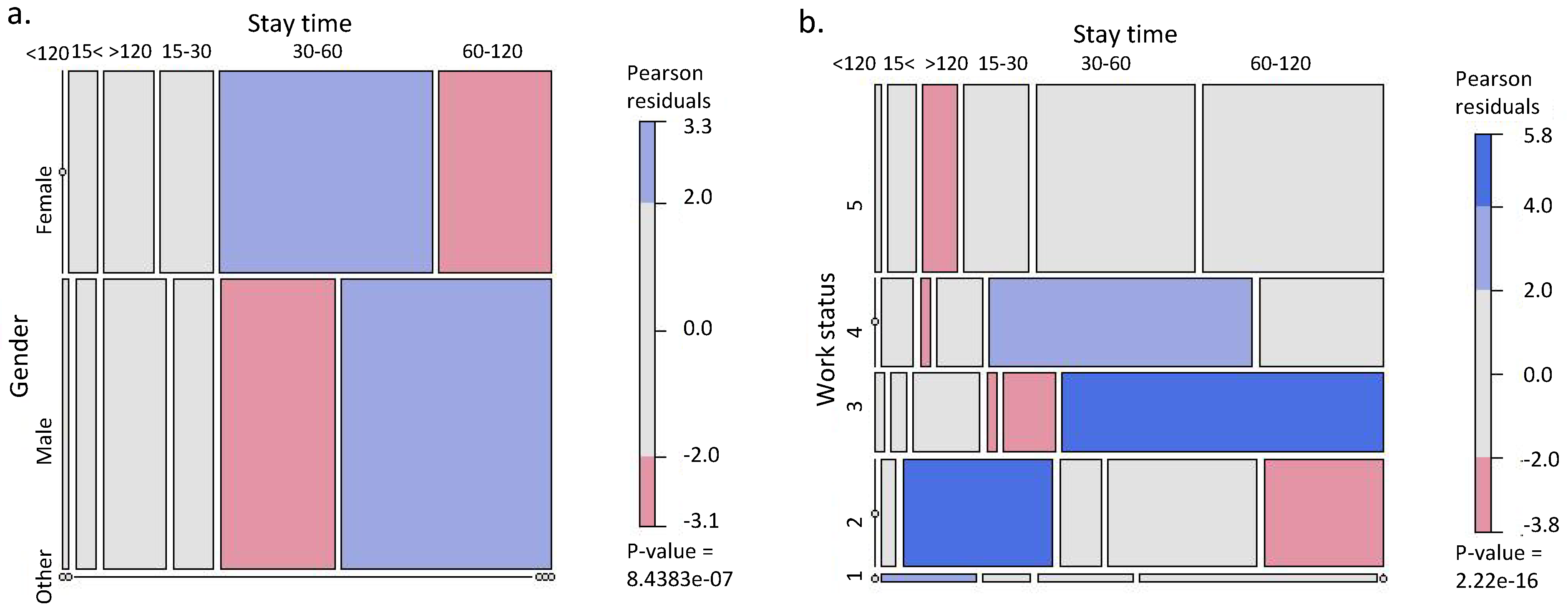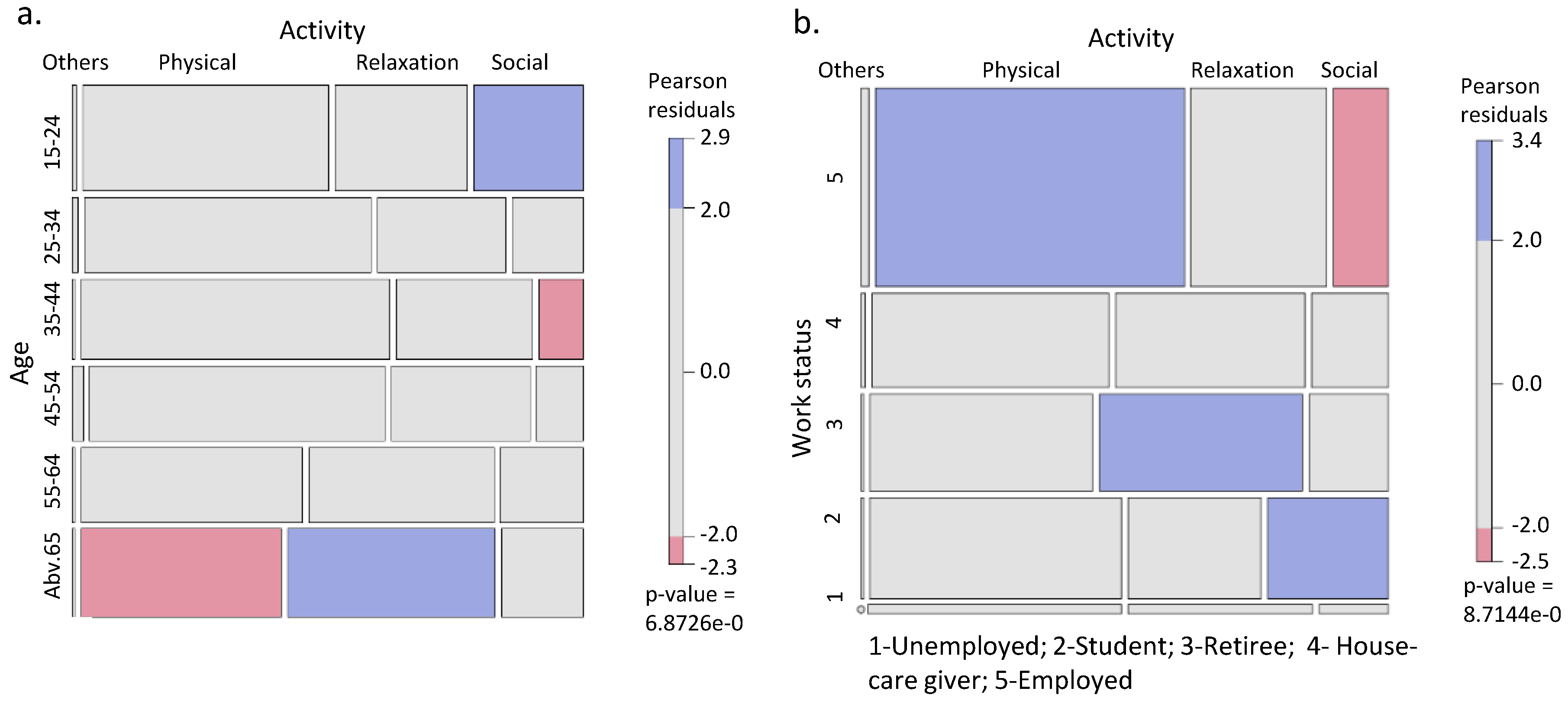Preferences and Perception Influencing Usage of Neighborhood Public Urban Green Spaces in Fast Urbanizing Indian City
Abstract
1. Introduction
2. Methods and Materials
2.1. Research Framework
2.2. Case Study
2.3. Data Collection and Sampling
2.4. Data Analysis
3. Results
3.1. Respondents Socio-Demographic
3.2. Preferences: Neighborhood PUGS Visitation, Preferred Typology, Visitation Time and Frequency, Stay Time
3.3. Preferred Activities and Motives of Visitation
3.4. Perceived Satisfaction toward Neighborhood PUGS Characteristics
4. Discussion
4.1. Local Preferences, Visitation, and Usage
4.2. Activities, Motives and Assigned Values
4.3. Local Perceptions and Satisfaction
4.4. Recommendations, Limitations and Future Research
5. Conclusions
Supplementary Materials
Author Contributions
Funding
Data Availability Statement
Acknowledgments
Conflicts of Interest
References
- Conedera, M.; Del Biaggio, A.; Seeland, K.; Moretti, M.; Home, R. Residents’ preferences and use of urban and peri-urban green spaces in a Swiss mountainous region of the Southern Alps. Urban. For. Urban. Green. 2015, 14, 139–147. [Google Scholar] [CrossRef]
- Hadavi, S.; Kaplan, R. Neighborhood satisfaction and use patterns in urban public outdoorspaces: Multidimensionality and two-way relationships. Urban. For. Urban. Green. 2016, 19, 110–122. [Google Scholar] [CrossRef]
- Mahmoudi Farahani, L.; Maller, C. Perceptions and Preferences of Urban Greenspaces: A Literature Review and Framework for Policy and Practice. Landsc. Online 2018, 22, 61. [Google Scholar] [CrossRef]
- Wendel, H.; Zarger, R.; Mihelcic, J. Accessibility and usability: Green space preferences, perceptions, and barriers in a rapidly urbanizing city in Latin America. Landsc. Urban. Plan. 2012, 107, 272–282. [Google Scholar] [CrossRef]
- Shackleton, C.M.; Blair, A. Perceptions and use of public green space is influenced by its relative abundance in two small towns in South Africa. Landsc. Urban. Plan. 2013, 113, 104–112. [Google Scholar] [CrossRef]
- Grilli, G.; Mohan, G.; Curtis, J. Public park attributes, park visits, and associated health status. Landsc. Urban. Plann. 2020, 199, 103814. [Google Scholar] [CrossRef]
- Kabisch, N.; Qureshi, S.; Haase, D. Human–environment interactions in urban green spaces—A systematic review of contemporary issues and prospects for future research. Environ. Impact Assess. Rev. 2015, 50, 25–34. [Google Scholar] [CrossRef]
- Neema, M.N.; Maniruzzaman, K.M.; Ohgai, A. Green Urbanism Incorporating Greenery-Based Conceptual Model towards Attaining a Sustainable Healthy Livable Environment—Dhaka City’s Perspective. Curr. Urban. Stud. 2013, 1, 19–27. [Google Scholar] [CrossRef]
- Pauleit, S.; Ambrose-Oji, B.; Andersson, E.; Anton, B.; Buijs, A.; Haase, D.; Elands, B.; Hansen, R.; Kowarik, I.; Kronenberg, J.; et al. Advancing urban green infrastructure in Europe: Outcomes and reflections from the GREEN SURGE project. Urban. For. Urban. Green. 2019, 40, 4–16. [Google Scholar] [CrossRef]
- Ahern, J.; Cilliers, S.; Niemelä, J. The concept of ecosystem services in adaptive urban planning and design: A framework for supporting innovation. Landsc. Urban. Plan. 2014, 125, 254–259. [Google Scholar] [CrossRef]
- United Nations. Resolution Adopted by the General Assembly on 25 September 2015, Transforming Our World: The 2030 Agenda for Sustainable Development. 2015. Available online: https://upload.wikimedia.org/wikipedia/commons/d/d5/N1529189.pdf (accessed on 5 March 2023).
- Broussard, S.R.; Washington-Ottombre, C.; Miller, B.K. Attitudes toward policies to protect open space: A comparative study of government planning officials and the general public. Landsc. Urban. Plan. 2008, 86, 14–24. [Google Scholar] [CrossRef]
- Barbosa, O.; Tratalos, J.A.; Armsworth, P.R.; Davies, R.G.; Fuller, R.A.; Johnson, P.; Gaston, K.J. Who benefits from access to green space? A case study from Sheffield, UK. Landsc. Urban. Plan. 2007, 83, 187–195. [Google Scholar] [CrossRef]
- Buijs, A.; Hansen, R.; Van der Jagt, S.; Ambrose-Oji, B.; Elands, B.; Lorance Rall, E.; Mattijssen, T.; Pauleit, S.; Runhaar, H.; Stahl Olafsson, A.; et al. Mosaic governance for urban green infrastructure: Upscaling active citizenship from a local government perspective. Urban. For. Urban. Green. 2019, 40, 53–62. [Google Scholar] [CrossRef]
- Jim, C.Y. Sustainable urban greening strategies for compact cities in developing and developed economies. Urban. Ecosyst. 2013, 16, 741–761. [Google Scholar] [CrossRef]
- Haq, A.S.M.; Islam, M.N.; Siddhanta, A.; Ahmed, K.J.; Chowdhury, M.T.A. Public Perceptions of Urban Green Spaces: Convergences and Divergences. Front. Sustain. Cities 2021, 3, 755313. [Google Scholar] [CrossRef]
- Guenat, S.; Porras Lopez, G.; Mkwambisi, D.D.; Dallimer, M. Unpacking Stakeholder Perceptions of the Benefits and Challenges Associated with Urban Greenspaces in Sub-Saharan Africa. Front. Environ. Sci. 2021, 9, 591512. [Google Scholar] [CrossRef]
- Noël, C.; Landschoot, L.; Gadeyne, S. Social barriers for the use of available and accessible public green spaces. Front. Sustain. Cities 2021, 3, 744766. [Google Scholar] [CrossRef]
- Adegun, O.B. When green is grievous: Downsides in human-nature interactions in informal urban settlements. J. Urban. Int. Res. Placemaking Urban. Sustain. 2018, 11, 347–361. [Google Scholar] [CrossRef]
- Jim, C.; Chen, W.Y. Perception and Attitude of Residents Toward Urban Green Spaces in Guangzhou (China). Environ. Manag. 2006, 38, 338–349. [Google Scholar] [CrossRef]
- Keith, S.J.; Larson, L.R.; Shafer, C.S.; Hallo, J.C.; Fernandez, M. Greenway use and preferences in diverse urban communities: Implications for trail design and management. Landsc. Urban. Plan. 2018, 172, 47–59. [Google Scholar] [CrossRef]
- Cadieux, K.V. Political ecology of exurban “lifestyle” landscapes at Christchurch’s contested urban fence. Urban. For. Urban. Green. 2008, 7, 183–194. [Google Scholar] [CrossRef]
- Grahn, P.; Stigsdotter, U.A. Landscape planning and stress. Urban. For. Urban. Green. 2003, 2, 1–18. [Google Scholar] [CrossRef]
- Jim, C.Y.; Shan, X. Socioeconomic effect on perception of urban green spaces in Guangzhou, China. Cities 2013, 31, 123–131. [Google Scholar] [CrossRef]
- Kaczynski, A.T.; Henderson, K.A. Parks and recreation settings and active living: A review of associations with physical activity function and intensity. J. Phys. Act. Health 2008, 5, 619–632. [Google Scholar] [CrossRef] [PubMed]
- Schipperijn, J.; Ekholm, O.; Stigsdotter, U.K.; Toftager, M.; Bentsen, P.; Kamper-Jørgensen, F.; Randrup, T.B. Factors influencing the use of green space: Results from a Danish national representative survey. Landsc. Urban. Plan. 2010, 95, 130–137. [Google Scholar] [CrossRef]
- Tyrväinen, L.; Mäkinen, K.; Schipperijn, J. Tools for mapping social values of urban woodlands and other green areas. Landsc. Urban. Plan. 2007, 79, 5–19. [Google Scholar] [CrossRef]
- Bonaiuto, M.; Fornara, F.; Bonnes, M. Indexes of perceived residential environment quality and neighbourhood attachment in urban environments: A confirmation study on the city of Rome. Landsc. Urban. Plan. 2003, 65, 41–52. [Google Scholar] [CrossRef]
- Chiesura, A. The role of urban parks for the sustainable city. Landsc. Urban. Plan. 2004, 68, 129–138. [Google Scholar] [CrossRef]
- Neuvonen, M.; Sievänen, T.; Tönnes, S.; Koskela, T. Access to green areas and the frequency of visits—A case study in Helsinki. Urban. For. Urban. Green. 2007, 6, 235–247. [Google Scholar] [CrossRef]
- Swanwick, C. Society’s attitudes to and preferences for land and landscape. Land. Use Policy 2009, 26, S62–S75. [Google Scholar] [CrossRef]
- Rupprecht, C.D.D.; Byrne, J.A.; Ueda, H.; Lo, A.Y. ‘It’s real, not fake like a park’: Residents’ perception and use of informal urban green-space in Brisbane, Australia and Sapporo, Japan. Landsc. Urban. Plan. 2015, 143, 205–218. [Google Scholar] [CrossRef]
- Gashu, K.; Gebre-Egziabher, T.; Wubneh, M. Local communities’ perceptions and use of urban green infrastructure in two Ethiopian cities: Bahir Dar and Hawassa. J. Environ. Plan. Manag. 2020, 63, 287–316. [Google Scholar] [CrossRef]
- Ghandehari, M.R.E.; Ghafouri, F.; Ganjooe, F.A.; Zarei, A. Urban Parks Users’ Profile: A Case Study in Iran. World Appl. Sci. J. 2012, 16, 892–897. [Google Scholar]
- Smith, N.R.; Lewis, D.J.; Fahy, A.; Eldridge, S.; Taylor, S.J.C.; Moore, D.; Clark, C.; Stansfeld, S.A.; Cummins, S. Individual socio-demographic factors and perceptions of the environment as determinants of inequalities in adolescent physical and psychological health: The Olympic Regeneration in East London (ORiEL) study. BMC Public Health 2015, 15, 150. [Google Scholar] [CrossRef]
- Giles-Corti, B.; Broomhall, M.H.; Knuiman, M.; Collins, C.; Douglas, K.; Ng, K.; Lange, A.; Donovan, R.J. Increasing walking. Am. J. Prev. Med. 2005, 28, 169–176. [Google Scholar] [CrossRef]
- Wan, C.; Shen, G.Q. Salient attributes of urban green spaces in high density cities: The case of Hong Kong. Habitat Int. 2015, 49, 92–99. [Google Scholar] [CrossRef]
- Willemse, L. Community/Neighbourhood Park Use in Cape Town: A Class-Differentiated Analysis. Master’s Thesis, University of Stellenbosch, Stellenbosch, South Africa, 2010. [Google Scholar]
- Swanwick, C.; Dunnett, N.; Woolley, H. Nature, role and value of green space in towns and cities: An overview. Built Environ. 2003, 29, 94–106. [Google Scholar] [CrossRef]
- Haaland, C.; van den Bosch, C.K. Challenges and strategies for urban green-space planning in cities undergoing densification: A review. Urban. For. Urban. Green. 2015, 14, 760–771. [Google Scholar] [CrossRef]
- Park, Y.; Guldmann, J.M. Understanding disparities in community green accessibility under alternative green measures: A metropolitan-wide analysis of Columbus, Ohio, and Atlanta, Georgia. Landsc. Urban. Plan. 2020, 200, 103806. [Google Scholar] [CrossRef]
- Xu, C.; Haase, D.; Pribadi, D.O.; Pauleit, S. Spatial variation of green space equity and its relation with urban dynamics: A case study in the region of Munich. Ecol. Ind. 2018, 93, 512–523. [Google Scholar] [CrossRef]
- Ugolini, F.; Massetti, L.; Calaza-Martínez, P.; Cariñanos, P.; Dobbs, C.; Ostoic, S.; Marin, M.; Pearlmutter, D.; Saaroni, H.; Šaulienė, I.; et al. Understanding the benefits of public urban green space: How do perceptions vary between professionals and users? Landsc. Urban. Plan. 2022, 228, 104575. [Google Scholar] [CrossRef]
- Anguluri, R.; Narayanan, P. Role of green space in urban planning: Outlook towards smart cities. Urban. For. Urban. Green. 2017, 25, 58–65. [Google Scholar] [CrossRef]
- Lahoti, S.; Lahoti, A.; Saito, O. Benchmark assessment of recreational public Urban Green space provisions: A case of typical urbanizing Indian City, Nagpur. Urban. For. Urban. Green. 2019, 44, 126424. [Google Scholar] [CrossRef]
- Sankhe, S.; Vittal, I.; Dobbs, R.; Mohan, A.; Gulati, A.; Ablett, J.; Gupta, S.; Kim, A.; Paul, S.; Sanghvi, A.; et al. India’s Urban Awakening: Building Inclusive Cities, Sustaining Economic Growth; McKinsey & Company: New York, NY, USA, 2010; Available online: https://www.mckinsey.com/featured-insights/urbanization/urban-awakening-in-india (accessed on 5 March 2023).
- Dhyani, S.; Lahoti, S.; Khare, S.; Pujari, P.; Verma, P. Ecosystem based Disaster Risk Reduction approaches (EbDRR) as a prerequisite for inclusive urban transformation of Nagpur City, India. Int. J. Disaster Risk Reduct. 2018, 32, 95–105. [Google Scholar] [CrossRef]
- Surawar, M.; Kotharkar, R. Assessment of Urban Heat Island through Remote Sensing in Nagpur Urban Area Using Landsat 7 ETM+ Satellite Images. Int. J. Urban Civ. Eng. 2017, 11, 868–874. [Google Scholar]
- MoUD. Atal Mission for Rejuvenation and Urban (AMRUT); Ministry of Urban Development: New Delhi, India, 2015. Available online: http://amrut.gov.in/writereaddata/AMRUTGuidelines.pdf (accessed on 5 March 2023).
- Coles, R.; Grayson, N. Improving the quality of life in urban regions through urban greening initiatives—EU URGE-Project. In Proceedings of the Open Space People Space: An International Conference on Inclusive Environments, Edinburgh, UK, 27–29 October 2004; OPEN Space: Edinburgh, UK, 2004. [Google Scholar]
- Galero-Tejero, E. A Simplified Approach to Thesis and Dissertation Writing; National Book Store: Mandaluyong City, Philippines, 2011. [Google Scholar]
- Brandt, C.A.; Argraves, S.; Money, R.; Ananth, G.; Trocky, N.; Nadkarni, P. Informatics tools to improve clinical research study implementation. Contemp. Clin. Trials 2006, 27, 112–122. [Google Scholar] [CrossRef]
- Coons, S.J.; Gwaltney, C.J.; Hays, R.D.; Lundy, J.J.; Sloan, J.A.; Revicki, D.A.; Lenderking, W.R.; Cella, D.; Basch, E. Recommendations on Evidence Needed to Support Measurement Equivalence between Electronic and Paper-Based Patient-Reported Outcome (PRO) Measures: ISPOR ePRO Good Research Practices Task Force Report. Value Health 2009, 12, 419–429. [Google Scholar] [CrossRef]
- Gwaltney, C.J.; Shields, A.L.; Shiffman, S. Equivalence of Electronic and Paper-and-Pencil Administration of Patient-Reported Outcome Measures: A Meta-Analytic Review. Value Health 2008, 11, 322–333. [Google Scholar] [CrossRef]
- Aanensen, D.M.; Huntley, D.M.; Feil, E.J.; al-Own, F.; Spratt, B.G. EpiCollect: Linking Smartphones to Web Applications for Epidemiology, Ecology and Community Data Collection. PLoS ONE 2009, 4, e6968. [Google Scholar] [CrossRef]
- Lahoti, S.; Kefi, M.; Lahoti, A.; Saito, O. Mapping Methodology of Public Urban Green Spaces Using GIS: An Example of Nagpur City, India. Sustainability 2019, 11, 2166. [Google Scholar] [CrossRef]
- Schetke, S.; Qureshi, S.; Lautenbach, S.; Kabisch, N. What determines the use of urban green spaces in highly urbanized areas?—Examples from two fast growing Asian cities. Urban. For. Urban. Green. 2016, 16, 150–159. [Google Scholar] [CrossRef]
- Comber, A.; Brunsdon, C.; Green, E. Using a GIS-based network analysis to determine urban greenspace accessibility for different ethnic and religious groups. Landsc. Urban. Plan. 2008, 86, 103–114. [Google Scholar] [CrossRef]
- Burgess, J.; Harrison, C.M.; Limb, M. People, Parks and the Urban Green: A Study of Popular Meanings and Values for Open Spaces in the City. Urban. Stud. 1988, 25, 455–473. [Google Scholar] [CrossRef]
- Thompson, C.W. Urban open space in the 21st century. Landsc. Urban. Plan. 2002, 60, 59–72. [Google Scholar] [CrossRef]
- Van Herzele, A.; Wiedemann, T. A monitoring tool for the provision of accessible and attractive urban green spaces. Landsc. Urban. Plan. 2003, 63, 109–126. [Google Scholar] [CrossRef]
- Lo, A.Y.; Jim, C.Y. Willingness of residents to pay and motives for conservation of urban green spaces in the compact city of Hong Kong. Urban. For. Urban. Green. 2010, 9, 113–120. [Google Scholar] [CrossRef]
- Poudyal, N.C.; Hodges, D.G.; Merrett, C.D. A hedonic analysis of the demand for and benefits of urban recreation parks. Land. Use Policy 2009, 26, 975–983. [Google Scholar] [CrossRef]
- Sotoudehnia, F. A Spatial and Social Analysis of Green Space Access: A Mixed-Methods Approach for Analyzing Variations in Access Perceptions. Master’s Thesis, University of Leicester, Department of Geography, Leicester, UK, 2014. Available online: https://hdl.handle.net/2381/28625 (accessed on 5 March 2023).
- Payne, L.L.; Mowen, A.J.; Orsega-Smith, E. An Examination of Park Preferences and Behaviors Among Urban Residents: The Role of Residential Location, Race, and Age. Leis. Sci. 2002, 24, 181–198. [Google Scholar] [CrossRef]
- Lindsey, G.; Maraj, M.; Kuan, S. Access, Equity, and Urban Greenways: An Exploratory Investigation. Prof. Geogr. 2001, 53, 332–346. [Google Scholar] [CrossRef]
- Sherer, P.M. The Benefits of Parks: Why America Needs More City Parks and Open Space; The Trust for Public Land: San Francisco, CA, USA, 2006. [Google Scholar]
- Yilmaz, S.; Zengin, M.; Yildiz, N.D. Determination of user profile at city parks: A sample from Turkey. Build. Environ. 2007, 42, 2325–2332. [Google Scholar] [CrossRef]
- Krellenberg, K.; Welz, J.; Reyes-Päcke, S. Urban green areas and their potential for social interaction—A case study of a socio-economically mixed neighbourhood in Santiago de Chile. Habitat Int. 2014, 44, 11–21. [Google Scholar] [CrossRef]
- Parra, D.C.; Gomez, L.F.; Fleischer, N.L.; Pinzon, J.D. Built environment characteristics and perceived active park use among older adults: Results from a multilevel study in Bogotá. Health Place 2010, 16, 1174–1181. [Google Scholar] [CrossRef] [PubMed]
- Shan, X.-Z. Socio-demographic variation in motives for visiting urban green spaces in a large Chinese city. Habitat Int. 2014, 41, 114–120. [Google Scholar] [CrossRef]
- Rishbeth, C.; Finney, N. Novelty and Nostalgia in Urban Green Space: Refugee Perspectives. J. Econ. Hum. Geogr. 2006, 97, 281–295. [Google Scholar] [CrossRef]
- Wong, K.; Domroes, M. The Visual Quality of Urban Park Scenes of Kowloon Park, Hong Kong: Likeability, Affective Appraisal, and Cross-Cultural Perspectives. Environ. Plan. B Urban. Anal. City Sci. 2016, 32, 617–632. [Google Scholar] [CrossRef]
- Ellaway, A.; Macintyre, S.; Bonnefoy, X. Graffiti, greenery, and obesity in adults: Secondary analysis of European cross sectional survey. Br. Med. J. 2005, 331, 611–612. [Google Scholar] [CrossRef]
- Scottish Government. Planning Advice Note (PAN) 65 Provides Advice on the Role of the Planning System in Protecting and Enhancing Existing Open Spaces and Providing High Quality New Spaces. 2008. Available online: https://www.gov.scot/publications/planning-advice-note-pan-65-planning-open-space/ (accessed on 5 March 2023).
- Greenhalgh, L.; Worpole, K. Park Life: Urban Parks and Social Renewal; Demos: London, UK, 1995. [Google Scholar]
- Reyes, S.; Figueroa, I.M. Distribution, size and accessibility of green areas in Santiago, Chile. Estud. Urbanos Reg. 2010, 36, 89–110. [Google Scholar]
- Home, R.; Hunziker, M.; Bauer, N. Psychosocial outcomes as motivations for visiting nearby urban green spaces. Leis. Sci. 2012, 34, 350–365. [Google Scholar] [CrossRef]
- Coles, R.W.; Bussey, S.C. Urban forest landscapes in the UK—Progressing the social agenda. Landsc. Urban. Plan. 2000, 52, 181–188. [Google Scholar] [CrossRef]
- Maller, C.; Townsend, M.; Pryor, A.; Brown, P.; Leger, L.S. Healthy nature healthy people: ‘Contact with nature’ as an upstream health promotion intervention for populations. Health Promot. Int. 2006, 21, 45–54. [Google Scholar] [CrossRef]
- Berdejo-Espinola, V.; Suárez-Castro, A.F.; Amano, T.; Oh, R.R.Y.; Fielding, K.S.; Fuller, R.A. Urban green space use during a time of stress: A case study during the COVID-19 pandemic in Brisbane, Australia. People Nat. 2021, 3, 597–609. [Google Scholar] [CrossRef] [PubMed]
- Da Schio, N.; Philips, A.; Fransen, K. The impact of the COVID-19 pandemic on the use of and attitudes towards urban forests and green spaces: Exploring the instigators of change in Belgium. Urban. Urban. Green. 2021, 65, 127305. [Google Scholar] [CrossRef] [PubMed]
- Lu, Y.; Zhao, J.; Xueying, W.; Lo, S.M. Escaping to nature during a pandemic: A natural experiment in Asian cities during the COVID-19 pandemic with big social media data. Sci. Total Environ. 2021, 777, 146092. [Google Scholar] [CrossRef]
- Barker, A.; Booth, N.; Churchill, D.; Crawford, A. The Future Prospects of Urban Public Parks: Findings—Informing Change; University of Leeds: Leeds, UK, 2017; Available online: http://eprints.whiterose.ac.uk/126647/ (accessed on 5 March 2023).
- Kuo, F.E.; Sullivan, C. Aggression and violence in the inner city: Effects of environment via mental fatigue. Environ. Behav. 2001, 33, 543–571. [Google Scholar] [CrossRef]
- MacNaghten, P.; Urry, J. Bodies in the woods. Body Soc. 2000, 6, 166–182. [Google Scholar] [CrossRef]
- Peschardt, K.K.; Stigsdotter, U.K. Associations between park characteristics and perceived restorativeness of small public urban green spaces. Landsc. Urban. Plan. 2013, 112, 26–39. [Google Scholar] [CrossRef]
- Boone, C.G.; Buckley, G.L.; Grove, J.M.; Sister, C. Parks and People: An Environmental Justice Inquiry in Baltimore, Maryland. Ann. Assoc. Am. Geogr. 2009, 99, 767–787. [Google Scholar] [CrossRef]
- Chen, B.; Adimo, O.A.; Bao, Z. Assessment of aesthetic quality and multiple functions of urban green space from the users’ perspective: The case of Hangzhou Flower Garden, China. Landsc. Urban. Plan. 2009, 93, 76–82. [Google Scholar] [CrossRef]
- Beaney, K. Green Spaces in the Urban Environment: Uses, Perceptions and Experiences of Sheffield City Centre Residents. Ph.D. Thesis, University of Sheffield, School of Architecture, Sheffield, UK, 2009. Available online: https://etheses.whiterose.ac.uk/6140/ (accessed on 5 March 2023).
- Berney, R. Learning from Bogotá: How Municipal Experts Transformed Public Space. J. Urban. Des. 2010, 15, 539–558. [Google Scholar] [CrossRef]
- Crompton, J.L. The Impact of Parks on Property Values: A Review of the Empirical Evidence. J. Leis. Res. 2017, 33, 1–31. [Google Scholar] [CrossRef]
- Berman, M.G.; Kross, E.; Krpan, K.M.; Askren, M.K.; Burson, A.; Deldin, P.J.; Kaplan, S.; Sherdell, L.; Gotlib, I.H.; Jonides, J. Interacting with nature improves cognition and affect for individuals with depression. J. Affect. Disord. 2012, 140, 300–305. [Google Scholar] [CrossRef] [PubMed]
- Coley, R.L.; Sullivan, W.; Kuo, F.E. Where Does Community Grow: The Social Context Created by Nature in Urban Public Housing. Environ. Behav. 2016, 29, 468–494. [Google Scholar] [CrossRef]
- Mean, M.; Tims, C. Findings: Informing Change: Enhancing the Use of Public Spaces in Cities; Joseph Rowntree Foundation: York, UK, 2005. [Google Scholar]









| Characteristic | Number | Percentage (%) |
|---|---|---|
| Respondent type | Household | 48 |
| User | 52 | |
| Gender | Male | 56.9 |
| Female | 43.1 | |
| Age group | 15–24 | 24.1 |
| 25–34 | 17.3 | |
| 35–44 | 17.7 | |
| 45–54 | 14.9 | |
| 55–64 | 13.6 | |
| Above 65 | 12 | |
| Education | Below high school | 3.7 |
| High school | 15.7 | |
| Diploma | 7.6 | |
| Bachelors | 54.1 | |
| Masters | 15.4 | |
| PhD | 0.5 | |
| Employment status | Employed | 43.5 |
| Unemployed | 1.7 | |
| Retiree | 13.6 | |
| Student | 22.8 | |
| House care giver | 18 |
Disclaimer/Publisher’s Note: The statements, opinions and data contained in all publications are solely those of the individual author(s) and contributor(s) and not of MDPI and/or the editor(s). MDPI and/or the editor(s) disclaim responsibility for any injury to people or property resulting from any ideas, methods, instructions or products referred to in the content. |
© 2023 by the authors. Licensee MDPI, Basel, Switzerland. This article is an open access article distributed under the terms and conditions of the Creative Commons Attribution (CC BY) license (https://creativecommons.org/licenses/by/4.0/).
Share and Cite
Lahoti, S.A.; Lahoti, A.; Dhyani, S.; Saito, O. Preferences and Perception Influencing Usage of Neighborhood Public Urban Green Spaces in Fast Urbanizing Indian City. Land 2023, 12, 1664. https://doi.org/10.3390/land12091664
Lahoti SA, Lahoti A, Dhyani S, Saito O. Preferences and Perception Influencing Usage of Neighborhood Public Urban Green Spaces in Fast Urbanizing Indian City. Land. 2023; 12(9):1664. https://doi.org/10.3390/land12091664
Chicago/Turabian StyleLahoti, Shruti Ashish, Ashish Lahoti, Shalini Dhyani, and Osamu Saito. 2023. "Preferences and Perception Influencing Usage of Neighborhood Public Urban Green Spaces in Fast Urbanizing Indian City" Land 12, no. 9: 1664. https://doi.org/10.3390/land12091664
APA StyleLahoti, S. A., Lahoti, A., Dhyani, S., & Saito, O. (2023). Preferences and Perception Influencing Usage of Neighborhood Public Urban Green Spaces in Fast Urbanizing Indian City. Land, 12(9), 1664. https://doi.org/10.3390/land12091664











